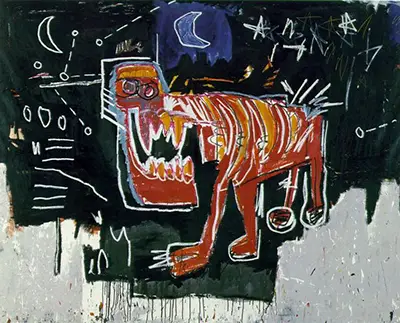This creature is menacing in appearance, with nashing teeth and a large, powerful jaw line. Basquiat chooses to cover most of the dog in a red tone, and then add extra detail with strokes of single lines, both in blue and white. This is how he tended to produce figurative art, where the solid and line would not quite meet perfectly, just as intended by the artist. The lower half is grey, with parts cut out which reminds us of the artist's roots in graffiti and other street art. Having added the dog itself, he would add detail around the black half of the composition, which is the upper half. We see several moons and a number of stars, all loosely depicted just as was his way. This feels entirely expressive, where the artist's deepest feelings are placed on the canvas, but without a concern for depicting anything with perfect, realistic detail.
Dog was completed in 1982 and this animal would feature several times in other Basquiat paintings, including Boy and Dog in a Johnnypump, of the same year. The former is now in a private collection and across the 1980s there was a concerted effort from a number of knowledgeable investors and collectors to acquire as many original artworks as possible from this artist, as there was a belief that their value would rise considerably in future years. This has proven entirely correct, though even they may have been surprised by the success that this artist's work was to later achieve, some years after his sad passing. Most original paintings from his career will now fetch millions of dollars, though most are now being stored with great pride and protection, with little interest from most in selling them on at this point.
Black art has been incredibly popular in recent years as a greater desire to make exhibitions and permanent displays far more inclusive has emerged. This seems likely to continue, perhaps even expand further, in coming years and Basquiat himself holds a reputation which was built many years ago. He can spearhead any focus on his culture's artistic history and his appeal is also particularly wide ranging. There seems little chance of interest in his career going cold anytime soon, and his work is sufficiently contemporary to attract new fans from younger generations into the future.


